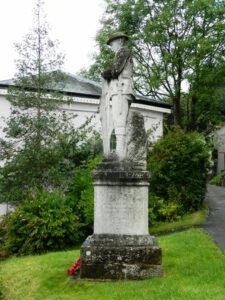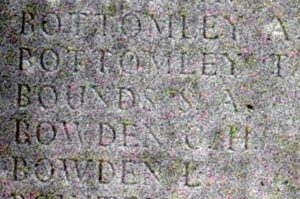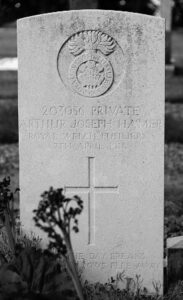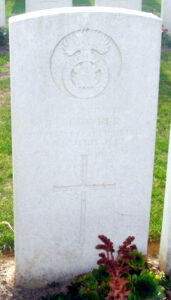New Radnor is situated in the heart of the county of Radnorshire, to the south of Radnor Forest, and was the original county town, built to replace Old Radnor. It was a planned medieval walled town with streets laid out in a grid pattern and is home to a ruined castle, which saw much bloodshed during its history.
The village war memorial sits aside the B4372 road, High Street, and takes the form of a soldier of the Great War, stood above a four-sided base, upon which is carved the names of the fallen from the village. The memorial is dedicated to the men of New Radnor and Llanfihangel Nantmelan who gave their lives in the Great War 1914-1919.

The Great War, 1914-1918
Samuel Albert Bounds, Private, 128204, Machine Gun Corps. Samuel was the son of John Bounds and Margaret Bounds (nee Jones), of Broad Street, New Radnor. He enlisted at Knighton into the army and was posted to the 9th Company, Machine Gun Corps. The company was attached to 9 Brigade, 3rd Division. Samuel probably joined the company in 1917, following the divisions efforts during the Battle of the Somme the previous year. During May 1917 the division was in the Arras sector and took part in the Battle of Arras, capturing the strongly defended village of Rouex. It was then moved north and took part in the Battle of Passchendaele, before being moved back south during November 1917, to take part in the Battle of Cambrai. The division was in the Cambrai sector when the Germans launched the first phase of their Spring Offensive on 21 March 1918 and suffered terrible casualties during the coming days. The division was then transferred to Flanders to rebuild, but became caught up in the second phase of the German offensive, on the Lys, from 9 April 1918. Samuel was killed in action in Flanders on 25 April 1918, aged 19. He has no known grave and is commemorated on the Tyne Cot Memorial, Belgium.

Arthur Sidney Evans, Private, 131742, Machine Gun Corps. Arthur was born on 4 January 1899, the son of Thomas and Sarah Evans, of Pool House, Kinnerton. He worked as a railway porter at New Radnor prior to enlisting into the army and was posted to the 63rd Battalion, Machine Gun Corps. The battalion was attached to the 63rd (Royal Naval) Division, which was formed to utilise the extra manpower which had been released due to the Royal Navy having more sailors than ships to place them on, and first saw service at Antwerp in August 1914 and then at Gallipoli in 1915. The division saw heavy fighting on the Somme, during the Battle of the Ancre in 1916 and in 1917 fought at the Battles of Arras, Passchendaele and Cambrai. The division was in the Arras area when the Germans launched their Spring Offensive on 21 March 1918 and took part in heavy fighting in the coming days. Arthur was killed during this terrible period, on 5 April 1918, aged 19. He is buried in Englebelmer Communal Cemetery, France. (Arthur is not named on the New Radnor Memorial, but at his native Kinnerton)
Herbert James Gittoes, Private, 42680, South Wales Borderers. Herbert was the son of Thomas and Mary Gittoes, of The Dingle, New Radnor. He enlisted into the army and was posted to the 2nd Battalion, South Wales Borderers, which was attached to 87 Brigade, 29th Division. The division had suffered terrible casualties during the Battle of the Somme, assaulting Y-Ravine on the opening day. In the Spring of 1917, the division took part in the opening of the Battle of Arras, before moving north to Ypres, taking part in several of the major actions there and again suffering terribly. In November the division moved to the Cambrai sector and took part in the Battle of Cambrai, before moving back to Flanders over the winter. During April 1918 the division became caught up in terrible fighting, following the German offensive which was launched on the Lys on 9 April 1918. After halting the Germans last ditch offensives, the Allies held the new line firm along the Western Front before launching their first fight-back, during the Battle of Villers-Brettoneux on 8 August. This was the turning point of the war, and successive offences were launched all along the line from 21 August onwards. The 29th Division was in the line around Outtersteene Ridge by now, readying to advance. On 27 August the 2nd SWB were in trenches to the north of the town of Outtersteene when they came under heavy artillery fire, losing fifty men killed or wounded. Herbert was among those killed that day. He was 18 years old and is buried in Borre British Cemetery, France.
Arthur Joseph Hamer, Private, 203056, Royal Welsh Fusiliers. Arthur was the son of Rice and Emily Hamer, of Downton Farm, New Radnor. He had spent some time in Canada before the war, but returned to enlist into the Montgomeryshire Yeomanry on 8 December 1914. He married Maud Ellen Pugh, of The Cock Hotel, Welshpool whilst on leave in 1916. Arthur did not embark for overseas service with the Montgomeryshire Yeomanry, who went to Egypt, but was transferred to No 5 Infantry Base Depot, before being posted to the 1/4th Battalion, Royal Welsh Fusiliers on 6 January 1917. The battalion was on the Somme, attached to the 47th (2nd London) Division. Early in 1917 the Division moved north to Belgium, and took part in the Battle of Messines, and then in November 1917 fought at the Battle of Cambrai. In March 1918 the Division was situated near St. Quentin, and faced the German Spring Offensive here on 21 March, taking part in heavy fighting whilst retreating back to the Somme valley. Arthur was badly wounded during the withdrawal to the Somme, and died of his wounds at the 1/8th London Field Ambulance on 7 April 1918, aged 32. He is buried in Herissart Communal Cemetery, France. His only son, Laurence Frederick Joseph Pugh Hamer, was born on 10 October 1918, six months after his death. Arthur is also commemorated on the Welshpool War Memorial. His brother, Fred, also fell.

Frederick George Hamer, Private, 55226, Royal Welsh Fusiliers. Frederick was the son of Rice and Emily Hamer, of Downton Farm, New Radnor. He worked on the family farm prior to enlisting into the Shropshire Yeomanry at Downton, Wiltshire. He was posted to France, probably in the summer of 1916 and joined the 2nd Battalion, Royal Welsh Fusiliers, which was attached to 19 Brigade, 33rd Division. The division saw heavy fighting on the Somme, especially during the fighting around High Wood. During March 1917 the 2nd RWF spent almost the entire month training in Camp 13, near Suzanne. It was during this month that one of the battalions most famous officers, Rupert Graves, was sent home sick. At the beginning of April the division began moving to the Arras sector and on 15 April 1917 the 2nd RWF moved into the trenches facing the Hindenburg Line, to which the Germans had retreated, in order to release some divisions to be sent to the Russian Front. Two days later the battalion was relieved, and moved into bivouacs near Mercatel and on 20 April moved back into the front line. On 23 April 1918 the 2nd RWF took part in an attack against the Hindenburg Line and throughout the day took part in desperate hand-to-hand fighting. By the end of the day, the battalion had lost five officers and 32 men killed; seven officers and 70 men wounded; and five men missing, for no gain. Among those killed during the day was Frederick Hamer. He was 23 years old and is buried in Heninel-Croisilles Road Cemetery, France. His mother received a letter from an officer of the battalion some time later, which read: ‘It is with sad regret I have to inform you of the death of your son, who was killed in action during the very heavy fighting on the 23rd of April. His body was recovered and buried on the battlefield, with his comrades who fell with him. He was a fine man, and very brave and good. His comrades will miss him. His brother, Arthur, was killed a year later.

James Jones, Private, 54128, Royal Welsh Fusiliers. James was the son of Thomas and Eliza Jones, of Folley, Llanfihangel, New Radnor. He worked as a coal hewer at Merthyr Tydfil prior to the war. James returned to Radnorshire to enlist at Knighton, and at some time in 1916 was posted to France, joining ‘A’ Company of the 2nd Battalion, Royal Welsh Fusiliers, which was attached to 19 Brigade, 33rd Division. The division moved to the Somme from the Loos sector in July 1916, reaching Meaulte on 15 July. The division saw heavy fighting around High Wood, before being withdrawn to rebuild, and the 2nd RWF spent most of October training at Lucheux before moving back to the front, near Trones Wood, on 22 October, beginning a strenuous tour in the line. On 5 November 1916 a party of men of the 2nd RWF under Second Lieutenant Loverseed was sent out to dislodge a party of Germans holding a position near Summer Trench, Briqueterie. James was killed during the fighting which resulted that day. He was 39 years old when he was killed on 5 November 1916 and is commemorated on the Thiepval Memorial, France.
Joseph William Jones, Private, 266288, South Lancashire Regiment. Joseph was the son of Joseph and Mary Jones, of 3, Greenfield Road, Presteigne. He worked as a tailor and outfitter prior to enlisting at Cardiff into the Welsh Regiment on 31 July 1916. It was almost a year before Joseph was sent to France, and on 22 July 1917 he joined the 2/4th Battalion, South Lancashire Regiment, which was attached to 172 Brigade, 57th Division. The Division had moved to France during February 1917, and moved to positions near Ypres, where it took part in the Second Battle of Passchendaele. In 1918, the division took part in the great offensive which was launched on 21 August 1918, fighting at the Battle of the Scarpe, and at the Battle of Drocourt-Queant. The division fought on the Hindenburg Line during the Battle of the Canal du Nord, which opened the path to capture the important town of Cambrai, which had been held by the Germans since 1914. Joseph was killed in action on 4 October 1919, during the drive to Cambrai. He was 32 years old and is buried in Anneux British Cemetery, France.
Thomas Stanley Jones, Private, 18134, King’s Shropshire Light Infantry. Thomas was born at Four Stones, Old Radnor, the son of James and Mary Jones. The family later resided in Ross Hurst, Presteigne. Thomas worked as a horseman at Trewern prior to enlisting at New Radnor into the King’s Shropshire Light Infantry, and was posted to the 1st Battalion, King’s Shropshire Light Infantry, which was attached to 16 Brigade, 6th Division. The division had been in France since 10 September 1914 and had fought on the Aisne. During 1915 it had seen terrible fighting at Ypres, during the Action of Hooge and in 1916 moved to the Somme, where the Division fought at the Battle of Flers-Courcelette, the Battle of Morval and the Battle of Le Transloy. The following year saw the division at Arras, where it fought at the Battle of Hill 70. Thomas was probably wounded during heavy fighting near the Crassiers on 22 April 1917. He died of his wounds at Bethune on 29 April 1917, aged 20 and is buried in Bethune Town Cemetery, France. Thomas is not commemorated on the New Radnor War Memorial.
David Nicholls, Private, 26508, South Wales Borderers. David was the son of William and Margaret Nicholls, of Castle Cottage, New Radnor. He enlisted at Walton into the 3rd Battalion, South Wales Borderers and was sent out to Mesopotamia (now Iraq) to join the 4th Battalion, South Wales Borderers, which was attached to the 13th Division. The battalion had originally fought at Gallipoli with the division before the evacuation of the peninsula and in February 1916 was sent from Egypt to Mesopotamia, alongside several other divisions sent by the British in an attempt to break the siege of Kut. The 4th SWB saw its first major action in Mesopotamia during an assault on the Hanna position on 4 April 1916, in an action which saw one of its officers, Captain Angus Buchanan, gain the award of the Victoria Cross. Four days later the battalion attacked the Sannaiyat positions, and another member of the battalion, Private James Henry Fynn, gained the award of the Victoria Cross for his gallantry for rescuing two wounded men. David was wounded in Mesopotamia, probably during the same attack by a bombing party from the battalion on 14 February 1917 which saw one of its VC winners, Captain Angus Buchanan, wounded. He died of his wounds that day, on 14 February 1917, aged 29. David is buried in Amara War Cemetery, Iraq.
Albert Edward Probert, Private, 55502, Royal Welsh Fusiliers. Albert was the son of George and Frances Probert, of Nash Lime Works, Presteigne. He worked as a waggoner at Upper House Farm, Evenjobb prior to the war. Albert enlisted at New Radnor into the Montgomeryshire Yeomanry, but at some time, probably in the summer of 1916, was posted to France, joining the 17th Battalion, Royal Welsh Fusiliers, which was attached to 115 Brigade, 38th (Welsh) Division. He probably joined the battalion after the division had been withdrawn from the Somme sector, following its terrible ordeal in Mametz Wood. The division then trained in Northern France before being posted to the line north of Ypres, along the Ieperlee Canal, in the Boesinghe area. The division remained in the Boesinghe sector for almost a year and on 31 July 1917 launched its assault on the Pilckem Ridge, as part of the opening of the Third Battle of Ypres. Following a successful period at Ypres, the division moved to the Armentieres sector for the winter and at the end of March 1918 moved back to the Somme, to hold a section of the line north of Albert. Albert was wounded whilst on a working party near Forceville on 18 July 1918, when the Germans shelled their positions. He died of his wounds on 20 June 1918, aged 27 and is buried in Bagneux British Cemetery, Gezaincourt, France. Albert is not commemorated on the New Radnor War Memorial, but at Presteigne.
Charles Lewis Williams, Private, 12490, King’s Shropshire Light Infantry. Charles was the son of Lewis and Agnes Elizabeth Williams, of Red Lion, Llanfihangel Nantmellan, New Radnor. He enlisted at Llandrindod Wells into the King’s Shropshire Light Infantry and was posted the 6th Battalion, King’s Shropshire Light Infantry, which was attached to 60 Brigade, 20th (Light) Division. Charles embarked with the battalion for France on 24 July 1915 and upon its arrival, the entire division moved to the Fleurbaix Sector for trench familiarisation and training. When the Battle of Loos was launched on 25 September 1915 the Division fought a diversionary attack towards Fromelles. Later that year it moved north, and fought at the Battle of Mount Sorrel alongside the Canadian Corps. The division then fought through the Somme Offensive, and took part in the advance to the Hindenburg Line in March 1917. Later that year it took part in the Third Battle of Ypres, before moving south in November, to take part in the Battle of Cambrai. The division remained in the area between Cambrai and St. Quentin over the winter of 1917/18 and was attacked there by the German Spring Offensive of 21 March 1918. During the morning of 21 March 1918 the 6th KSLI was in billets at Cugny and with the situation in the front critical, moved forwards towards the Battle Zone, taking up the line from the Somme to Vaux. Charles was killed in action soon afterwards, on the night of 21 March 1918. He was 28 years old and is buried in Ham British Cemetery, Muille-Villette, France. He is also commemorated on the Llandrindod Wells War Memorial.
World War Two, 1939-1945
John Eric Jones, Corporal, 573164, Royal Air Force. John was the son of Lewis and Susanna Frances Jones, of New Radnor. He enlisted into the Royal Air Force and was posted to 21 Operational Training Unit at RAF Moreton in Marsh. On 23 July 1941 John was riding pillion on a motor cycle owned by his friend, Eric Edward Sheppard, when they collided with some stray cattle on a road at Bourton Hill Quarries, near Blockley. John was killed outright, and Eric died in hospital. John was just 19 years old when he died that day and was buried with full military honours in Moreton-in-Marsh Cemetery. The inscription at the base of his headstone reads: ‘KILLED IN ROAD ACCIDENT THY WILL BE DONE’.
Arthur Henley, Private, 5512940, Hampshire Regiment. Arthur was born on 14 April 1907, the son of Jim and Edith Henley, of Alford, Surrey. He married Edith Eleanor Ford in 1933 and by 1939 was working as a gardener and living at Farnham, Surrey. Arthur enlisted into the army and was posted to the 5th Battalion, Hampshire Regiment, which was attached to the 128th Infantry Brigade, 43rd (Wessex) Division. The entire brigade was transferred to the 46th Division on 15 August 1942 and in January 1943 embarked for North Africa to take part in the Operation Torch landings. The 5th Hampshires saw heavy fighting soon after arriving, being assaulted by German paratroopers and elements of the 10th Panzer Division at Sidi N’sir. The division fought throughout the remainder of the North African campaign and following the surrender of the Afrika Korps made an assault landing at Salerno in September 1943. The 5th Hampshires suffered a large number of casualties during a German counter-attack, as a result of landing in the wrong position. Arthur had survived all of this heavy fighting, but was killed during the crossing of the River Volturno on 13 October 1943. He was 35 years old and is buried in Minturno War Cemetery, Italy. The base of his headstone is inscribed: ‘LOVED IN LIFE HONOURED IN DEATH’. Arthur is not commemorated on the New Radnor War Memorial, although his widow, Edith, lived in the village towards the end of the war.
Alfred Thomas Lloyd, Leading Aircraftman, 1418101, Royal Air Force Volunteer Reserve. Alfred was born on 22 January 1922, the son of James and Clara Lloyd, of The Knowle Farm, New Radnor. He was studying at University when war broke out, then volunteered to serve with the Royal Air Force Volunteer Reserve. He was posted to America to train with No 5 BFTS, as part of the Empire Air Training Scheme. He had just passed out to be able to fly solo, and was accidentally drowned, when four of his friends threw him into a pool at Carlstrom Field, to celebrate his success. Alfred failed to return to the surface and was pulled out of the water by his friends, who failed to revive him. The 19-year-old was buried with full military honours in Oak Ridge Cemetery, Arcadia, USA.
John Walter Moses, Trooper, 7938421, Royal Armoured Corps. John was born on 2 February 1904, the son of John Walter and Jane Moses, of The Rack, New Radnor. He married Eva Mary Chubb in 1936 and the couple set up home at Pendree, New Radnor. John enlisted into the army and was posted to the 22nd Dragoons, which was attached to the Royal Armoured Corps. Little else is currently known of John, but he died at New Radnor on 27 January 1942, aged 37, and is buried in St. Mary’s Churchyard, New Radnor. The base of his headstone is inscribed: ‘GOD’S GREATEST GIFT, REMEMBRANCE’.